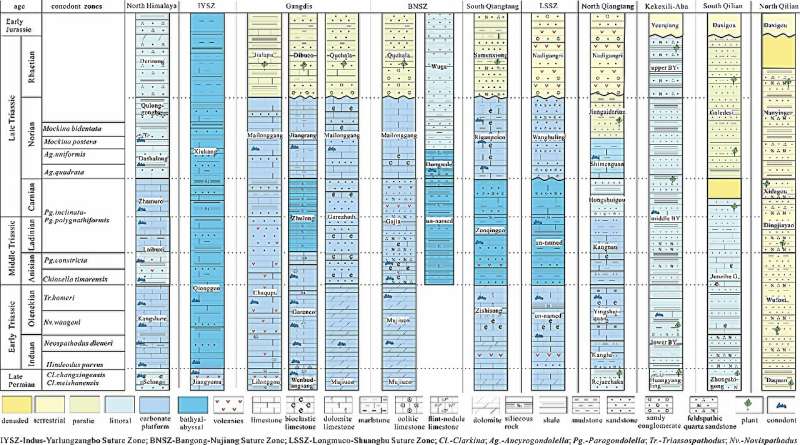This article has been reviewed according to Science X's editorial process and policies. Editors have highlighted the following attributes while ensuring the content's credibility:
fact-checked
peer-reviewed publication
trusted source
proofread
Triassic biostratigraphy, lithostratigraphy and paleogeography of the Qinghai-Tibetan Plateau

In a paper published in Science China Earth Sciences, a team of scientists proposes a comprehensive summary of the main fossil sequences and lithostratigraphy of the Qinghai-Tibetan Plateau (QTP) during the Triassic time.
They point out that Triassic marine deposits spread extensively across the Lhasa and South Qiangtang blocks as well as the Bangongco-Nujiang Suture Zone (BNSZ). This observation leads to an improved explanation of the Triassic tectonic setting of the QTP that invokes a "two continents and one basin" model as opposed to the "three continents and two geosynclines" and "archipelagic arc-basin system" models.
Results of the present study suggest that Triassic deposits of the QTP are of great oil and gas exploration potential. Based on their analysis of sedimentary successions of different stratigraphic divisions, the authors make the case that the Indus-Yarlungzangbo Suture Zone (IYSZ) served as a rift axis during Triassic time in which sedimentary facies shallowed symmetrically to the south and north.
Additionally, the research group describes for the first time the Triassic sedimentary paleogeography of the QTP in terms of four periods, namely Early Triassic, Middle Triassic to Late Triassic Carnian, Late Triassic Norian, and Late Triassic Rhaetian rather than the previously described two periods (Early-Middle Triassic and Late Triassic).
The geographic distribution of the dominant fossils, including plants, brachiopods, corals, ammonoids, and conodonts, suggest that the IYSZ, more so than the BNSZ, served as an important paleobiogeographic barrier during the Triassic.
They further point out that the rifting of the Pangean Supercontinent in the Early to Middle Triassic time and the Late Triassic Indosinian Orogeny were the two major tectonic events that affected the QTP during the Triassic.
The former comprises a stratigraphic succession that reflects a deepening of the entire QTP during the Early to Late Triassic Carnian time; the latter is largely represented by strata that record the transition of a carbonate-dominated marine setting to a coastal and terrestrial clastic-dominated setting by Late Norian time in the north of the IYSZ.
More information: Guichun Wu et al, Triassic integrative stratigraphy, biotas, and paleogeographical evolution of the Qinghai-Tibetan Plateau and its surrounding areas, Science China Earth Sciences (2024). DOI: 10.1007/s11430-023-1188-5
Journal information: Science China Earth Sciences
Provided by Science China Press




















